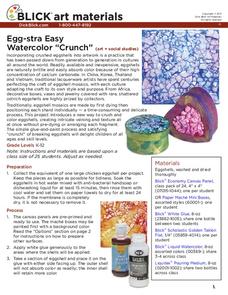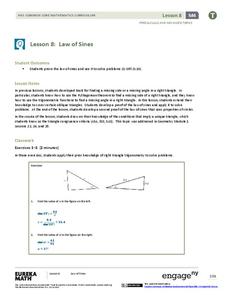Curated OER
Seven Great Ways to Make Quilts With Colors You Love
Students design a quilt on their own with guided practice in this six week course. The first week is called spontaneity class, the second is called color enrichment, and the third week is call value study. During the fourth week students...
Curated OER
Which Colors Absorb the Most Energy?
Students measure the temperatures over time of different colored envelopes in order to explore the different rates at which each color absorbs energy from a heat lamp. They record their data and graph their results.
Curated OER
Kool Colors
Students practice creating art with household items. In this tie dye lesson, students utilize packets of Kool-Aid, warm water and vinegar to create die. Students twist rubber bands on white t-shirts and dip the segments to create a...
Lake Science Collaborative
Blood Circulation Simulation
Act out the circulation of blood in the body with an innovative activity. Kids act as either body parts or blood, and carry necessary nutrients and waste throughout different stations to represent the way that oxygen circulates.
NOAA
A Watery World
With about 70% of the earth's surface covered in oceans, it's fair to say that we live in a very wet world. Young scientists gain a better appreciation of this fact as they use maps to identify the world's ocean basins in the first...
Dick Blick Art Materials
Egg-Stra Easy Watercolor “Crunch”
It doesn't have to be Easter to enjoy this egg-stra fun art project. Kids crunch egg shells, saturate them with color, and glue them to boxes or other objects to make egg-stra special gifts.
Dick Blick Art Materials
Art Press Tools
Kids cast their own plaster tools to stamp image impressions and textures for tiles, pictures frames, and other works of art. Young artists can even create their own watermark to label their stuff.
NASA
Feel the Heat
Pupils examine how solar energy can supply power and heat on the lunar surface. As groups design and build a solar-powered water heating system, they test their system to determine the change in temperature of the water and redesign it...
EngageNY
Are All Parabolas Similar?
Congruence and similarity apply to functions as well as polygons. Learners examine the effects of transformations on the shape of parabolas. They determine the transformation(s) that produce similar and congruent functions.
EngageNY
Graphing the Logarithmic Function
Teach collaboration and communication skills in addition to graphing logarithmic functions. Scholars in different groups graph different logarithmic functions by hand using provided coordinate points. These graphs provide the basis for...
EngageNY
Getting a Handle on New Transformations 1
In the first of a two-day lesson plan on transformations with matrix notation the class transforms the unit square using general transformations, then calculates the area of the transformed image. They discover it is the same as finding...
EngageNY
Law of Sines
Prove the Law of Sines two ways. The ninth segment in a series of 16 introduces the Law of Sines to help the class find lengths of sides in oblique triangles. Pupils develop a proof of the Law of Sines by drawing an altitude and a second...
EngageNY
Basic Properties of Similarity
Does the symmetry and transitive property apply to similarity? The 10th segment in a series of 16 presents the class with a group of explorations. The explorations have pairs show that similarity is both symmetrical and transitive. It...
EngageNY
Law of Cosines
Build upon the Pythagorean Theorem with the Law of Cosines. The 10th part of a 16-part series introduces the Law of Cosines. Class members use the the geometric representation of the Pythagorean Theorem to develop a proof of the Law of...
EngageNY
Properties of Dilations
Investigate dilations to learn more about them. The second segment in a series of 16 provides a discussion of properties of dilations by going through examples. The problem set provides opportunities for scholars to construct dilations.
EngageNY
Definition of Rotation and Basic Properties
Examine the process of rotating images to visualize effects of changes to them. The fifth lesson of 18 prompts pupils to rotate different images to various degrees of rotation. It pays special attention to rotations in multiples of 90...
EngageNY
Sequencing Rotations
Discover the result of a sequence of rotations about different centers. Pupils perform rotations to examine the patterns. They also describe the sequence of rotations that performed to reach a desired result in the ninth installment in a...
Virginia Department of Education
Constructions
Pupils learn the steps for basic constructions using a straightedge, a compass, and a pencil. Pairs develop the skills to copy a segment and an angle, bisect a segment and an angle, and construct parallel and perpendicular lines.
EngageNY
Chance Experiments with Equally Likely Outcomes
Take a deeper dive into equally likely probabilities. Pupils build upon their understanding of probability by determining sample spaces and outcomes. Individuals work with sample spaces and determine outcomes that are equally likely....
EngageNY
Comparing Ratios Using Ratio Tables
Decide which concentration of mixtures is the strongest. Pupils use tables to compare ratios involved in mixtures. They use two methods to make the comparisons — by finding equivalent values within the tables or by comparing the values...
Prestwick House
Rhyme and Repetition in Poe's "Annabel Lee"
Many and many a year ago Edgar Allan Poe crafted the chilling tale of "Annabel Lee." The poem is the perfect vehicle to introduce Poe's concept of unity of effect, the idea that every element in a poem or story should help to develop a...
University of Texas
Lives of Stars
Stars exist from a few million years to over 10 billion years, depending on their mass. Scholars perform a play acting as stars to learn about their different life cycles. They develop an understanding of many of the fundamental concepts...
K20 Learn
Annotating a Text: Style and Syntax
New ReviewIf you have a favorite author, you probably recognize their style. Conduct a close read of the text, marking it up as they go. Collaborative sharing time and a summary writing prompt follow the main activity.
Meadows Center for Preventing Educational Risk, University of Texas at Austin
Lesson 16 - Adding Vowel Suffixes to CVC and Silent E Base Words
There's a big difference between hoping and hopping. A lesson on adding vowel suffixes discusses when to double a consonant before adding a suffix such as -ed or -ing. Readers practice breaking down words into syllables and creating new...

























